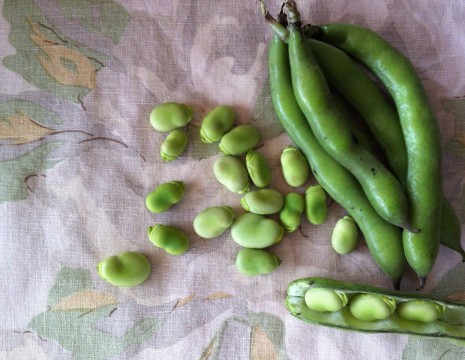THE FIRST FAVA BEANS
The closest Manhattan comes to a village green is the farmers market at Union Square, and the chance to catch up with friends is part of the pleasure of shopping there. One of the Saturday morning regulars is Roy Finamore, a longtime cookbook editor, author, food stylist, and all-around good egg. This week, he delivered his “hey, girl” smooch as usual, but it was clear his attention was elsewhere. “What’s up?” I asked. “You okay?”
He gave me a soulful look. “Favas,” he said. He threw a glance at the market stall occupied by Lani’s Farm, a purveyor of pristine greens from south Jersey. There, on the table nearest us was a pile of the glossy swollen pods. They had undeniable star quality.
“I dunno,” I replied, conscious of a busy weekend and a jam-packed week ahead. “They can be so much work.” They need to be popped out of their pods, but there is another step as well: Unless the beans are very small, after cooking, they must also be divested of their second skin, which turns bitter as the favas mature. Well worth the effort, but still, an effort.
“Oh, these are so tender, you can eat them raw,” Roy countered. “All you need is olive oil and salt.” Simple words, but enough to galvanize me: I started working my way through the scrum to that heap of beans, and when I looked up, Roy was gone.
The fava bean, Vicia faba, may look like a lima or other shell bean, but those belong to a different, New World genus of the legume family. The fava has an Old World pedigree; it’s been a staple of the European and Middle Eastern diet for thousands of years. Driven in large part by the demands of chefs, the fresh fava has become a seasonal draw at farmers markets here in the U.S., but it’s not exactly a newcomer. A quick dip into Will Weaver’s Heirloom Vegetable Gardening reveals that the bean was popular in kitchen gardens from Colonial times to the 1840s, when it gradually fell out of fashion.
I first had favas in England, where they’re known as broad beans, and it seems fitting to indulge this week in honor of the Diamond Jubilee. “The Old Broad Bean” is Cockney slang for Her Maj, and if a commemorative tea towel or mug isn’t your style, then I would think seriously about the dried broad-bean cufflinks or a necklace lacquered and painted with a likeness of the Queen from Swedish Blonde Design. Can scrimshaw be far behind?
One evening, we started off dinner with some of the fava beans raw, just as Roy suggested, with sea salt and our best olive oil. I didn’t stand on ceremony, but plunked a bowl of the beans in the pod on the table, so we could shell and eat our own. Making the prep a part of dinner gives you time to marvel at the soft white lining of the pods: Each bean looks like it’s nestled in cotton wool. Fresh goat cheese—mild and creamy, with just the right amount of tang—and a few slices of a garlicky sausage rounded out things nicely. All we had room for afterward was cold roast chicken and leftover broccoli rabe, heated until just warmed through.
Last night, after shelling the remaining favas, I realized I had a mixture of the small beans and larger ones, which would, I thought, benefit from cooking. I sorted them by size, then blanched the big ‘uns in a pot of boiling water for about two minutes. After draining, I slit their second, tight-fitting skins with a fingernail and peeled them easily enough. Then I combined the fresh and blanched beans in a bowl and dressed them with olive oil, Sherry vinegar, a squeeze of lemon juice, and some s & p.
Into the salad bowl went watercress and the tender, pale interior leaves from a head of escarole. A few mint leaves would have been very nice, too, but I didn’t have any. Instead I added a scattering of parsley and celery leaves, then the beans, and a little more oil and vinegar. Lo and behold, there was a remnant of Pecorino in the fridge, so shavings of that went on top of the salad, and I added a few curls of Parmigiano, for good measure. A damp, chilly evening in early June requires something hot and restorative, so the lamb stew destined for the freezer ended up on the stovetop instead. We ate that first, to warm our bones, then finished off with the salad.
I thought about emailing Roy to ask him what he did with his haul, but never mind. We’ll compare notes on Saturday morning.
Posted: June 5th, 2012 under Market Stories, people + places, recipes, spring.
Comments
Comment from admin
Time June 10, 2012 at 7:45 am
Dear Kathy,
That is most exciting–I have never seen a fresh red bean, let alone eaten one! Where is your farmers market? And, ahh–purple hull peas…I just had breakfast, and you have made me hungry all over again!
Comment from Sara
Time June 9, 2012 at 6:40 pm
Hi Jane,
Favas are the best. Since you like them, you should try this Persian dish called Baghali Ghatogh, which can be made with either lima or fava beans. http://www.bonappetempt.com/2012/03/baghali-ghatogh.html
Comment from admin
Time June 10, 2012 at 7:39 am
Dear Sara,
It sounds lovely! Thanks for sharing….
Cheers,
Jane



Comment from kathy
Time June 6, 2012 at 7:16 am
Nice! I found fresh red beans (kidney) at my farmer’s market last saturday; they are delicious! I’m still hoping that one year someone might grow purple hull peas, as these are my all-time favorites.